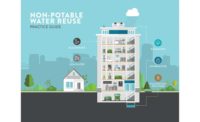The writers of an upcoming e-book aimed at demystifying the reuse of on-site nonpotable water have some advice for architects: Don’t go to building-permit officials with a confrontational attitude. That’s one tip in the guide, which presents strategies for building teams to advocate and get permits for systems to treat blackwater, graywater and captured rainwater.
Set for the Nov. 8-10 Greenbuild International Conference in Boston, the official release of the “Non-Potable Water Reuse Practice Guide” is later than planned due to the sudden death last January of the guide’s leader, architect Bill Worthen of the Urban Fabrick Collaborative.
“Bill brought a great deal of expertise to the project,” says Brett Rosenberg, who replaced Worthen as principal investigator for the free e-guide, primarily sponsored by a $60,000 grant from the Charles Pankow Foundation. “Aside from making us sad, Bill’s death galvanized us to get the guide done in a fashion he would have found suitable,” adds Rosenberg, Urban Fabrick’s project manager and leader of the e-book’s 36-person working group.
The content defines on-site water reuse, what it entails and why it is important. “It is incumbent on us” to make it clear that an on-site water-reuse system is safe if installed, operated and maintained properly, says Rosenberg.
The hope is that the 128-page guide will make it easier for design teams—architect, landscape architect, and civil and mechanical engineers—to develop an integrated water strategy for a building, based on the view that water is a “precious resource, not a commodity,” says Matthew Jones, a civil engineering principal at Magnusson Klemencic Associates and a member of the guide’s working group.




Post a comment to this article
Report Abusive Comment